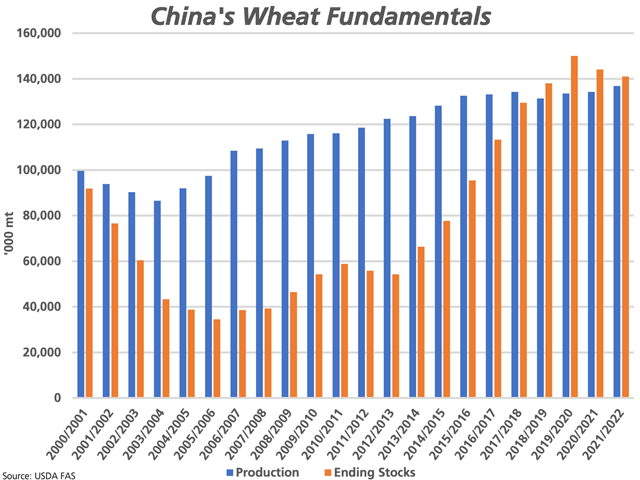World Wheat Faces Changes
Wheat Bulls Welcome Recent USDA and IGC Reports
On Thursday, Oct. 21, the International Grains Council's (IGC) October report included a forecast for global wheat trade in 2021-22 to reach a record high 194 million metric tons (mmt), revised 3 mmt higher, which is also 3 mmt higher than their 2020-21 forecast. This remains lower than the USDA October World Agricultural Supply and Demand Estimates (WASDE) estimate of 199.6 mmt, which is down slightly from the 2020-21 estimate of 201.3 mmt.
Read DTN's October WASDE report review here: https://www.dtnpf.com/…
While the forecasts vary, the point is that wheat trade remains robust, despite escalating prices. The IGC noted sustained buying from China and Iran, along with interest from Pakistan, Iraq and Turkey. Egypt, the world's largest wheat buyer, canceled a tender on Oct. 13 due to high prices, but we watch for their return soon.
There seems to be a steady flow of supportive news supporting global wheat markets, with the latest USDA WASDE report revising 2021-22 global ending stocks lower by 6.04 mmt to 277.18 mmt, down from their 2020-21 estimate of 288.36 mmt. Stocks held by the world's eight largest exporters (Argentina, Australia, Canada, European Union, Kazakhstan, Russia, Ukraine and the United States) total 50.017 mmt, down 17% from 2020-21 and would be the lowest reported since 2007-08, or 14 years. On a percentage of total global stocks basis, this represents 18% of the total global stocks, well below the high of 48% in 2005-06.
P[L1] D[0x0] M[300x250] OOP[F] ADUNIT[] T[]
While the focus has largely been on the 2021-22 crop, this week's news has also placed a spotlight on prospects for 2022-23. On Oct. 21, DTN changed their view of weather from a neutral factor for wheat markets to a bullish factor. The focus on Thursday was excessive rains in key areas of China, indicated as much as 300% to 400% of normal over the previous 15 days. The planting pace of winter wheat is reported at a pace that is roughly 50% of the normal pace. This struggle to plant the winter crop prior to winter conditions bears watching, while disease remains a concern for developing crop. It is important to note that DTN views weather as just one of many factors affecting the market.
While there is always a great deal of uncertainty over estimates for China's crops, the chart posted with this column, based on USDA Foreign Agriculture Service data, shows that China's wheat production (blue bars) has only faced one year-over-year decline in production in the past 18 years, or since 2003-04 when production was estimated 2.1% lower in the 2018-19 crop year. The country last faced back-to-back production declines in the four years from 2000-01 to 2003-04, when production declined 24%.
China's estimated ending stocks are indicated by the brown bars on the chart. Ending stocks estimated at 141 mmt for 2021-22 account for roughly 51% of global stocks given USDA's estimate, lower for a second year. This data begs questions at a time when China is importing the largest volumes seen since 1995-96, or 25 years.
The Oct. 22 DTN weather video focused on the National Oceanic and Atmospheric Administration (NOAA) U.S Seasonal Drought Outlook, pointing to an extended drought pattern forecast for the U.S. Southern Plains over the Oct. 21 through Jan. 31 period, which will affect one-third of U.S. winter wheat area. This week, USDA estimates that approximately 41% of the U.S. winter wheat area is facing some degree of drought, along with 89% of the spring wheat area. The latest Canadian Drought Monitor, as of Sept. 30, reports that 60% of the Prairie region is facing moderate to exceptional drought (D1-D4), which includes an estimated 99% of the region's agricultural land.
Production concerns faced in both major exporting countries, as well as a major importing nation such as China, have provided additional ammunition for market bulls. On Oct. 22, contract highs had been reached on the December MGEX hard red spring wheat contract, the December Kansas City hard red winter wheat contract and the December European milling wheat contract on the Euronext Exchange. In the case of spring wheat, the psychological resistance of $10 per bushel has been broken for the first time since July 2012.
Times are changing for the global wheat market.
Cliff Jamieson can be reached at cliff.jamieson@dtn.com
Follow Cliff Jamieson on Twitter @Cliff Jamieson
(c) Copyright 2021 DTN, LLC. All rights reserved.




